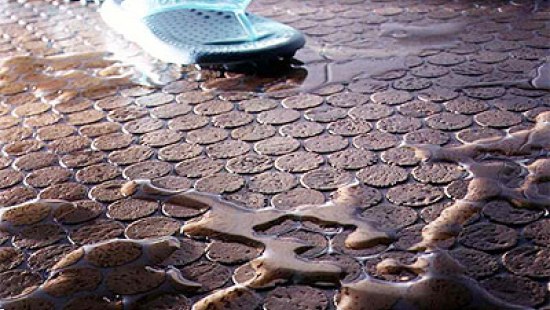Floor heating and cork floor covering

Cork as a floor covering for dry living spaces is nothing new. With its yellow-brown colour it seems pleasantly warm just when you look at it, and of course when you touch it. More and more often, you can encounter cork not only with its natural colouring but also in various colour shades, and at first sight it is almost impossible to tell that what you’re looking at is cork.
Cork has very good thermal insulation qualities, and due to this it would seem to be unsuitable for use with floor heating. However, cork is only a good insulator when it is laid in a thick layer, and in the thicknesses used for floor coverings it retains all of its qualities while being suitable for use with floor heating.
We conducted a laboratory test to confirm that this is true.
We used cork tiles from the firm Korek Jelínek spol. s.r.o., gluing them to an anhydride board with an ECOFLOOR LSDTS 80 W/m² heating mat installed approx. 50 mm under the cork so that the warmth from the cable was conveyed to the surface sufficiently and the temperature on the surface was evenly distributed. Styrotrade 20 mm extruded polystyrene was used as thermal insulation under the Ecofloor heating mat.
The maximum temperatures reached and the dynamics of the temperature build-up on the floor surface (in blue), on the cable of the heating mat (red), between the loops of the heating mat (green) and the surrounding temperature (violet).
The temperature of the floor increased from the room temperature of 21.5 °C to 29 °C but did not rise any further even without the use of a thermostat's limiting floor probe. It can be seen from the graph that the temperature increase is gradual even in the case of the temperature of the anhydride between the cable loops. The fact that all of the temperatures increase evenly, and that the anhydride with the heating cable does not overheat, means that the movement of heat through the floor covering in the direction of the area to be heated is fluid, and that the cork floor doesn't obstruct the movement of heat into the room and thus is suitable for use with floor heating.
The 80 W/m² output used is sufficient in new buildings and in reconstructed buildings with thermal facades, and in many cases might even be too high. For this reason we didn't test higher area outputs.
Cork floors can be used in all living spaces, including bathrooms. Cork must be treated with layers of lacquer as detailed in the instructions issued by the firm Korek Jelínek spol. s.r.o.
In conclusion, it is possible to definitively recommend cork tiles for use in combination with Ecofloor floor heating.
Korek Jelínek spol. s.r.o.
Ještědská 492
468 02 Rychnov u Jablonce nad Nisou
tel +420 483 388 327
fax +420 483 388 328
www.korek-jelinek.cz
www.korek.cz






